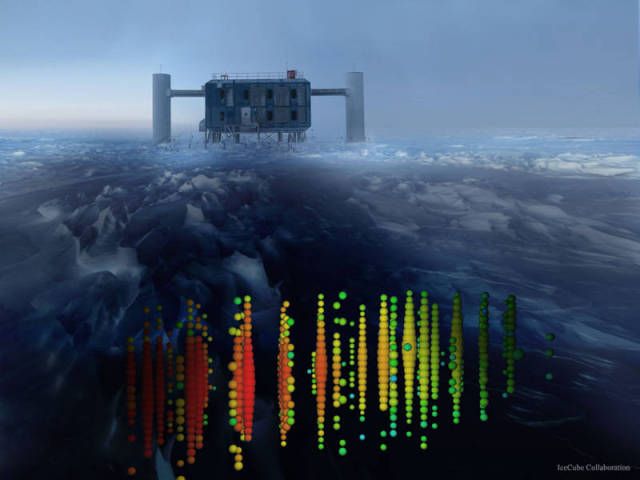The IceCube Neutrino Observatory near the South Pole, in Antarctica, has begun to detect neutrinos, nearly invisible particles of very high energy.
Image credit IceCube Collaboration
Although these rarely-interacting neutrinos pass through much of the Earth just before being detected, where they started remains a mystery. Pictured here is IceCube’s Antarctic lab accompanied by a cartoon depicting long strands of detectors frozen into the crystal clear ice below.
Scientists say neutrinos come from sources beyond our Milky Way galaxy. The ability to discover them heralds a new form of astronomy.
Candidate origins for these cosmic neutrinos include the violent surroundings of supermassive black holes at the centers of distant galaxies, and tremendous stellar explosions culminating in gamma ray bursts far across the universe. As IceCube detects increasingly more high energy neutrinos, correlations with known objects may resolve this cosmic conundrum — or we may never know.
The IceCube detector, sunk deep in the ice beneath the South Pole, lights up as a high-energy neutrino transits the detector on Nov. 13, 2010.
According to a UW-Madison statement:
The evidence is important because it heralds a new form of astronomy using neutrinos, the nearly massless high-energy particles generated in nature’s accelerators: black holes, massive exploding stars and the energetic cores of galaxies.
The particles created in these events, including neutrinos and cosmic rays, are accelerated to energy levels that exceed the record-setting earthbound accelerators such as the Large Hadron Collider (LHC) by a factor of more than a million.
They are prized by astrophysicists because the information they hold is pristine, unchanged as the particles travel millions of light-years between their sources and Earth. The ability to study the highest-energy neutrinos promises insight into a host of problems in physics, including how nature builds powerful and efficient particle accelerators in the universe.
via APOD






Leave A Comment